You’ll maximize your smartwatch’s sunlight visibility by choosing displays with at least 2,500 nits brightness and enabling sunlight mode for dynamic brightness boosts. Select devices with transflective or reflective LCD technology rather than OLED, as LCDs typically exceed 500 nits and outperform OLEDs in direct sunlight. Apply anti-reflective coatings to reduce glare by up to 75%, use high-contrast watch faces, and manually adjust brightness settings for real-time optimization. Advanced techniques and emerging technologies can further enhance your outdoor viewing experience.
Understanding Display Technology Options for Outdoor Visibility
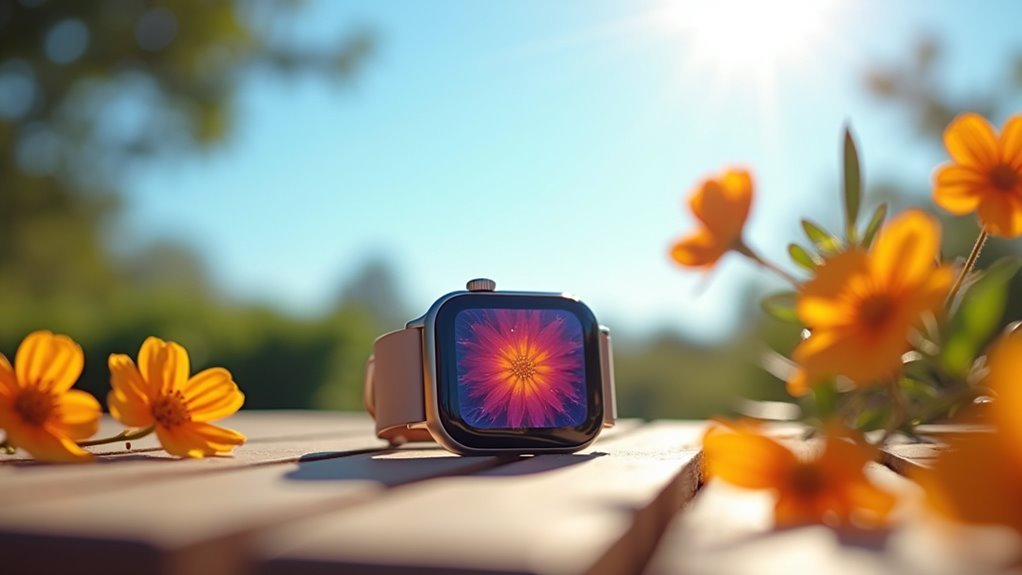
When you’re struggling to read your smartwatch display under bright sunlight, the underlying display technology makes all the difference in visibility and battery performance.
Transflective LCDs combine transmissive and reflective properties, using ambient light to illuminate your screen while maintaining low power consumption. These displays excel in direct sunlight by reflecting external light through LCD layers, making them ideal for always-on smartwatch displays.
AMOLED displays offer vibrant colors and high contrast but struggle with direct sunlight due to lower reflectivity. They’re better suited for changing outdoor conditions including shadows, where deep contrast provides consistent visibility.
However, AMOLED screens consume more power when backlit.
MicroLED technology delivers extremely high brightness around 4000 nits, ensuring excellent outdoor visibility but at increased power consumption and heat generation costs. Future smartwatch developments will likely introduce curved displays and bendable options to enhance wearability and user experience.
Brightness Requirements and Nits Standards for Direct Sunlight
The blazing noon sun transforms your smartwatch display into an unreadable black mirror unless it packs serious brightness capabilities. Your device needs at least 1000 nits for shaded areas, but direct sunlight demands 2500 nits or more to maintain readability.
Without sufficient brightness, your smartwatch becomes a useless black mirror under the merciless glare of direct sunlight.
At 1000 nits, you’ll lose 47% of perceived brightness in harsh conditions, while 3000-nit displays retain over 85% visibility. Modern smartwatches achieve optimal sunlight readability by incorporating anti-glare features alongside high nit ratings to minimize surface reflections.
Key brightness considerations for maximum outdoor performance:
- Minimum threshold: 1350 nits provides adequate smartwatch readability in most sunny conditions
- Premium performance: 2500+ nits guarantees crystal-clear visibility even in blazing direct sunlight
- Contrast preservation: Higher brightness maintains color accuracy and prevents washout effects
- Power trade-off: Increased brightness drains battery faster and generates more heat
- Technology limitations: OLED displays may struggle with polarization when wearing sunglasses
OLED Vs LCD Performance in Bright Outdoor Conditions
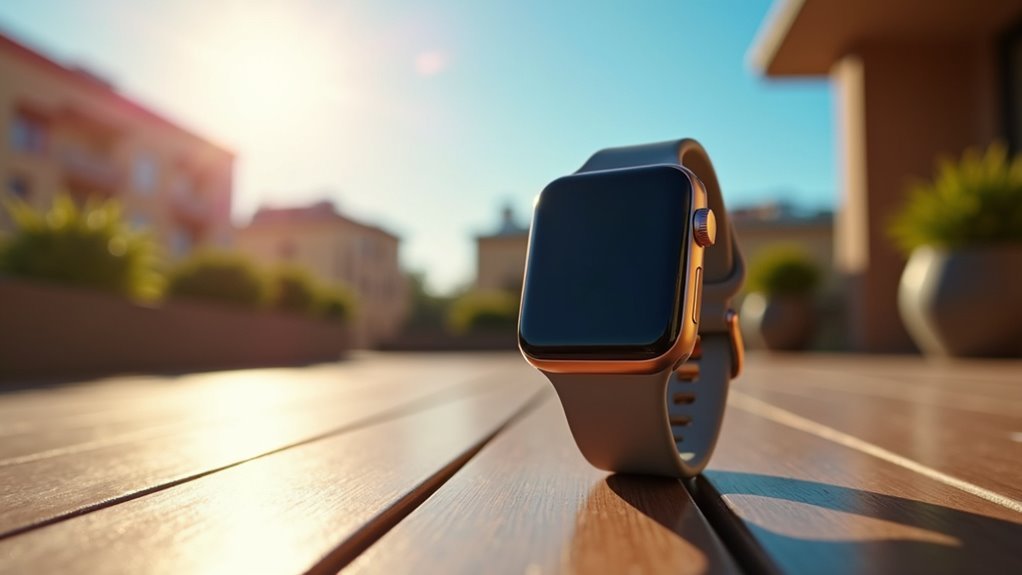
Achieving those brightness levels depends heavily on your smartwatch’s display technology, with OLED and LCD screens delivering dramatically different outdoor performance.
LCD smartwatches typically outshine OLED models in direct sunlight, often exceeding 500 nits through constant backlighting. While OLED displays can reach 400-500 nits, they’re usually optimized for indoor use and battery preservation rather than maximum outdoor visibility.
You’ll notice LCD screens maintain consistent brightness across lighting conditions due to their stable backlight, while OLEDs dynamically adjust to preserve battery life.
However, OLEDs offer superior contrast, deeper blacks, and better viewing angles when they’re not overwhelmed by glare. The trade-off becomes clear: LCDs generally win for pure brightness output, but OLEDs provide better color accuracy and contrast when sufficient brightness is achieved.
Premium smartwatches from manufacturers like Apple and Huawei feature AMOLED screens despite their higher cost, reflecting the advanced technology’s superior performance capabilities.
Reflective and Transflective Screen Technologies Explained
You’ll find reflective and transflective LCD technologies offer unique solutions for smartwatch visibility challenges.
Reflective LCDs harness ambient light to display content without backlighting, dramatically reducing power consumption while maintaining excellent readability in bright conditions.
Transflective displays combine the best of both worlds by switching between reflective and transmissive modes, adapting automatically to varying light conditions throughout your day. These displays achieve their dual functionality through a transflector layer typically made from sheet polymer that acts similar to a one-way mirror.
Reflective LCD Benefits
Several key advantages make reflective LCD technology particularly valuable for smartwatch displays, with power efficiency and outdoor visibility leading the benefits.
You’ll experience dramatically reduced power consumption since these displays eliminate the need for backlighting, consuming at least ten times less energy than traditional screens. This translates to considerably longer battery life for your device.
Reflective LCD displays use liquid crystals between glass layers that control light transmission, reflecting ambient light back to the viewer to create clear images.
The outdoor performance advantages are equally impressive:
- Superior sunlight readability – maintains clear visibility even in direct sunlight
- Enhanced contrast preservation – images remain sharp under bright conditions
- Elimination of screen washout – avoids common outdoor visibility problems
- Reduced glare and heat generation – improves user comfort during extended use
- Lighter, thinner form factor – creates more portable and comfortable wearables
Transflective Display Advantages
While reflective LCD displays excel in bright conditions, transflective technology takes versatility a step further by combining both reflective and transmissive capabilities in a single screen.
You’ll get ideal visibility whether you’re outdoors in bright sunlight or indoors under dim lighting. The display automatically switches between modes, using ambient light when available and activating the backlight only when necessary.
This dual functionality greatly extends your smartwatch’s battery life since you’re not constantly draining power for backlighting. You’ll also enjoy a thinner, lighter device design. These displays are commonly found in smartphones and tablets, making the technology well-established and reliable.
However, you’ll notice some trade-offs including reduced color saturation compared to AMOLED screens and potentially slower refresh rates. Despite these limitations, transflective displays offer an excellent balance of power efficiency and visibility for daily smartwatch use.
E-paper Display Benefits for Sunlight Readability
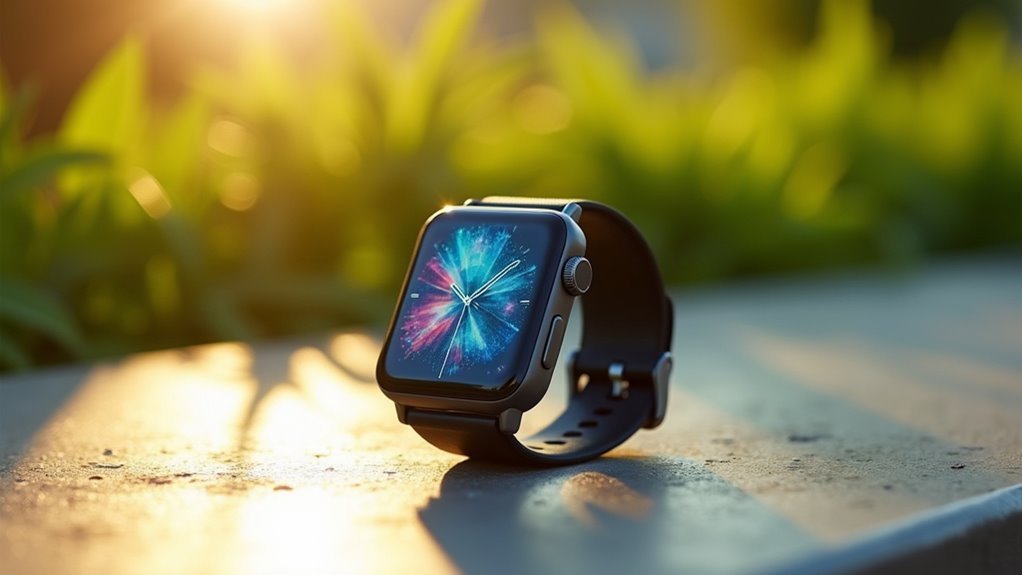
E-paper displays excel in bright sunlight conditions where traditional smartwatch screens often become unreadable or washed out.
You’ll appreciate how these screens consume virtually no power when displaying static content, allowing your smartwatch to maintain an always-on display without draining the battery.
This technology gives you weeks of battery life while ensuring you can read notifications, fitness data, and time clearly even under direct sunlight. The electrophoretic display technology offers exceptional readability and flexibility, making it ideal for wearable devices that need to perform reliably in various lighting conditions.
Exceptional Sunlight Visibility
When you’re trying to read your smartwatch display under blazing sunlight, traditional LCD and OLED screens often become frustratingly dim and washed out.
E-paper technology solves this problem by reflecting ambient light rather than competing with the sun’s brightness. Unlike backlit displays that struggle against direct sunlight, e-paper maintains crystal-clear readability in the harshest outdoor conditions.
The reflective nature of e-paper displays delivers several key advantages for outdoor smartwatch use:
- High contrast ratios that rival printed paper, ensuring text remains sharp and distinct
- Matte surface finish that eliminates glare and reflections from bright sunlight
- Wide viewing angles that preserve clarity regardless of your wrist position
- Vibrant color reproduction on advanced cholesteric liquid crystal variants
- Zero backlight washout issues that plague conventional display technologies
Advanced e-paper displays can achieve up to 99% energy efficiency by utilizing reflected ambient light instead of power-hungry backlighting systems.
Minimal Power Consumption
Beyond delivering superior sunlight readability, e-paper technology transforms your smartwatch’s battery performance through remarkably low power consumption.
You’ll consume power only during screen updates—your display maintains static images without any energy draw. When updating six times daily, your 2-inch e-paper screen uses just 0.012 mAh compared to 720 mAh for equivalent TFT LCD displays.
E-paper’s reflective nature eliminates backlight requirements, drastically reducing power demands in bright sunlight conditions.
You’ll achieve always-on display functionality without constant power drain typical of OLED or LCD screens. This efficiency enables smaller batteries without sacrificing visibility, extending usage between charges considerably. The bistable technology ensures your displayed image remains visible indefinitely without requiring a constant power source.
For ideal power savings, maintain low update frequencies—e-paper remains most efficient with fewer than four daily refreshes, making it perfect for smartwatch applications.
Always-On Display Capability
Your smartwatch’s display stays perpetually active with e-paper technology, delivering constant information access without the battery penalties traditional screens impose.
Unlike conventional displays that drain power continuously, e-paper’s reflective nature guarantees you’ll see every notification, time check, and fitness metric clearly throughout your day.
This always-on capability transforms your smartwatch experience by eliminating the need to tap, twist, or gesture to activate the screen. E-paper displays operate through electrophoresis principles, which enables the screen to maintain visibility without requiring constant power refresh cycles.
You’ll maintain instant visibility whether you’re checking your heart rate during a workout or glancing at notifications during meetings.
- Instant information access without activation delays
- Consistent readability across varying lighting conditions
- Reduced dependency on gesture-based screen activation
- Enhanced practicality for outdoor activities and sports
- Seamless integration with health monitoring applications
Anti-Reflective Coatings and Glare Reduction Techniques
Since smartwatch screens often become nearly unreadable in bright sunlight or under harsh indoor lighting, anti-reflective (AR) coatings offer one of the most effective solutions for maximizing display visibility.
These thin, optically active layers reduce light reflection from 4% to as low as 1.8%, dramatically improving readability.
AR coatings work through interference, reflecting light waves out of phase so they cancel each other out.
Applied via magnetron sputtering using materials like magnesium fluoride, they’re most effective when coating both sides of your smartwatch’s glass.
You’ll notice reduced eye strain and enhanced aesthetics, as the coated screen appears almost invisible.
However, outer AR coatings can scratch over time.
That’s why many manufacturers apply coatings to the inside surface for protection. Multiple layers of AR coating target a broader range of light waves, with each additional layer improving the overall effectiveness of glare reduction.
Auto-Brightness and Adaptive Display Mode Settings
While anti-reflective coatings tackle external glare, your smartwatch’s auto-brightness feature works from within to enhance screen visibility by continuously monitoring ambient light conditions.
This adaptive display technology uses built-in light sensors to automatically adjust brightness levels, ensuring ideal readability whether you’re indoors or under bright sunlight. The feature also helps extend battery life by minimizing power consumption through dynamic brightness adjustments.
However, auto-brightness isn’t perfect. In challenging conditions, you’ll need to fine-tune these settings for maximum effectiveness:
- Access brightness controls through your device’s settings menu
- Override auto-brightness when it becomes too dim in low-light situations
- Customize brightness levels to match your personal preferences
- Combine auto-brightness with always-on display modes for convenience
- Manually boost brightness during outdoor activities for enhanced visibility
Understanding these adaptive features helps you maintain clear screen visibility across varying lighting conditions.
Always-On Display Features for Power Conservation
Always-on display (AOD) technology represents one of the most significant power management challenges in modern smartwatches, potentially reducing battery life by up to four times when enabled. You’ll find manufacturers employ OLED and AMOLED screens to minimize power consumption while maintaining continuous information display.
| Power Conservation Feature | Battery Impact |
|---|---|
| OLED/AMOLED Technology | Reduces consumption by 60% |
| Adjustable Refresh Rates | Extends runtime by 40% |
| Proximity Sensors | Saves 25% during inactivity |
| Brightness Optimization | Improves efficiency by 35% |
| Background Limit Controls | Adds 20% battery life |
You can customize AOD settings to balance functionality with battery performance. Disabling unnecessary features like Wi-Fi and limiting CPU speed further optimize power efficiency. Testing reveals that devices with the best idle autonomy often demonstrate the worst performance when AOD is activated. These strategies help you maintain essential information access without drastically compromising your smartwatch’s battery life.
Balancing Screen Visibility With Battery Life Management
Although modern smartwatches offer impressive brightness capabilities reaching up to 3000 nits for ideal outdoor visibility, you’ll need to master the delicate balance between screen readability and battery conservation to enhance your device’s daily performance.
Strategic brightness management involves several key approaches:
- Use darker watch faces — AMOLED-optimized designs consume considerably less power by minimizing lit pixels.
- Enable automatic brightness sensors — let your watch adjust brightness based on ambient light conditions without manual intervention.
- Lower brightness indoors — preserve battery power for times when maximum brightness is essential outdoors.
- Activate smart power-saving modes — utilize features that dim displays during inactivity periods.
- Schedule brightness profiles — customize power usage by setting maximum brightness only when needed.
Consider models with MIP displays that offer excellent outdoor readability with minimal power consumption, as these memory-in-pixel screens remain visible in bright sunlight without requiring high brightness levels.
These techniques guarantee ideal visibility while extending battery life throughout your day.
Manual Adjustments and Software Optimization Tips
Beyond automatic settings, you can fine-tune your smartwatch’s visibility through targeted manual adjustments and software optimizations that adapt to your specific usage patterns.
Access manual brightness controls through your settings menu or quick panel for real-time adjustments when auto-brightness falls short. Enable outdoor or sunlight mode, which dynamically boosts brightness and contrast when high ambient light is detected, reducing the need for constant manual tweaking.
Customize your display elements by switching to high-contrast watch faces and adjusting font sizes for better readability. Simplify background patterns to minimize visual noise that sunlight amplifies. Remember that high brightness can drain battery faster, so consider your usage duration when making adjustments.
Finally, increase touch sensitivity settings to guarantee responsive screen interaction when wearing gloves or dealing with bright sunlight glare affecting your ability to navigate the interface effectively.
Emerging Technologies and Future Display Innovations
You’ll soon benefit from revolutionary display materials that make current smartwatch screens look outdated.
Micro LED technology promises displays that stay brilliantly visible even in harsh sunlight while consuming less battery power than today’s AMOLED screens. Samsung’s new MicroLED display technology delivers 4000 nits peak brightness for exceptional visibility in any lighting condition.
Advanced AI-driven optimization will automatically adjust your screen’s brightness, contrast, and color temperature based on real-time lighting conditions around you.
Next-Generation Display Materials
When perovskite LEDs emerge as game-changing display materials, they’ll revolutionize smartwatch visibility through their exceptional light absorption and emission capabilities.
These multifunctional displays can simultaneously act as sensors and solar cells, extending your device’s battery life while maintaining crisp visibility.
Tandem OLEDs stack multiple layers to dramatically enhance brightness, making your screen readable even in direct sunlight.
Meanwhile, advanced PHOLED emitters and deuterated compounds improve stability and performance across varying lighting conditions.
Researchers at Linköping University have developed displays where LEDs can react to touch and other environmental inputs, creating truly interactive screens.
- Plasmonic OLEDs: Metal nanoparticles boost light extraction for superior brightness
- Quantum dot technology: Delivers enhanced color accuracy in bright environments
- Micro-lens arrays: Optimize light output for maximum visibility
- AI-driven materials: Machine learning discovers breakthrough display compounds
- Micro-LED displays: Provide exceptional brightness and energy efficiency
Advanced Sunlight Optimization
While breakthrough materials transform display technology at the molecular level, practical sunlight optimization requires sophisticated engineering solutions that work with today’s smartwatch hardware.
You’ll benefit from advanced ambient light sensors that dynamically adjust brightness and display modes based on real-time environmental analysis. AI-driven adaptive algorithms automatically optimize your screen’s visibility without manual intervention.
Hybrid display architectures combine multiple layers—like OLED with transparent monochrome LCD—giving you seamless shifts between display modes. Your primary color screen offshores tasks to power-efficient monochrome layers in bright conditions, enhancing readability without battery compromise.
Privacy filters maintain visibility while reducing reflections, and novel pixel geometries improve sunlight reflection efficiency. Transflective LCD technology excels in reflecting ambient light to create displays that become more visible as outdoor lighting intensifies. These innovations guarantee you’ll never squint at your smartwatch again, regardless of lighting conditions.
Frequently Asked Questions
Does Wearing Polarized Sunglasses Affect Smartwatch Screen Visibility?
Yes, you’ll experience reduced smartwatch visibility when wearing polarized sunglasses. The horizontal polarization in your lenses blocks the screen’s light waves, causing displays to appear dim, dark, or distorted.
Can Weather Conditions Like Humidity Impact Outdoor Screen Performance?
High humidity damages your smartwatch’s internal components, causing screen flickering and uneven brightness. Moisture infiltration affects circuitry, reduces visibility outdoors, and accelerates component degradation when combined with heat exposure.
Are There Specific Wrist Positioning Techniques to Reduce Sun Glare?
You can reduce sun glare by angling your wrist away from direct sunlight, creating shadows with your body, tilting the screen strategically, and temporarily covering it with your hand.
Do Screen Protectors Significantly Reduce Brightness and Outdoor Visibility?
Yes, screen protectors can reduce your smartwatch’s brightness by 30-44%, making outdoor visibility considerably worse. Blue light filters and glossy protectors worsen this effect, while anti-reflective or matte options minimize brightness loss.
Which Smartwatch Brands Perform Best in Extreme Desert Sunlight Conditions?
You’ll find Garmin and Coros watches excel in extreme desert sunlight. They’re designed with transflective displays and high brightness levels that maintain visibility when you’re facing intense direct sunlight conditions.
In Summary
You’ve learned how display technology directly impacts your smartwatch’s sunlight visibility. Choose devices with high-brightness OLED or transflective screens exceeding 1,000 nits for ideal outdoor performance. Don’t overlook e-paper displays if you prioritize readability over color vibrancy. Configure your always-on display settings and adjust brightness manually when needed. As emerging technologies like microLED advance, you’ll see even better visibility solutions that won’t compromise your battery life.

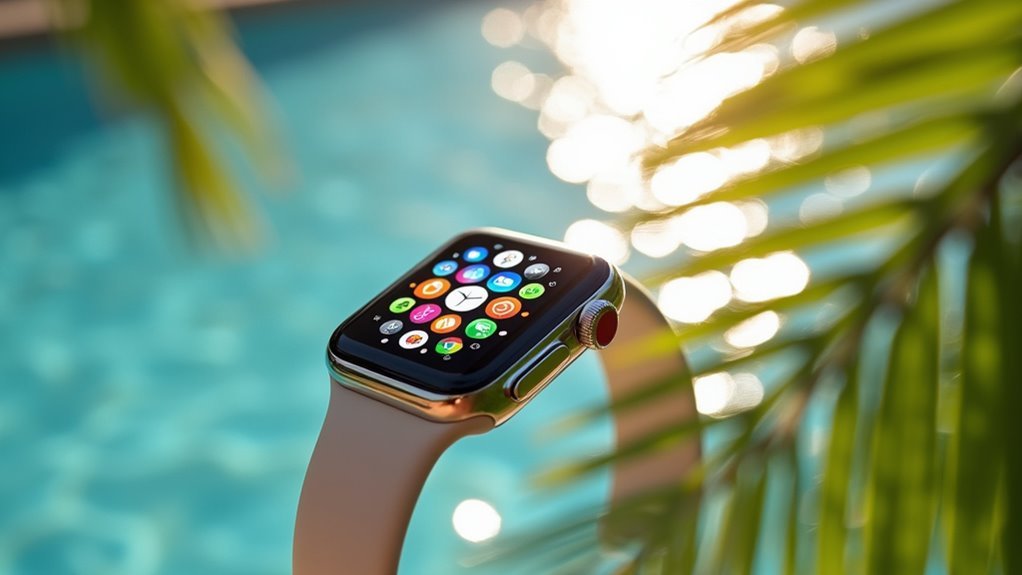
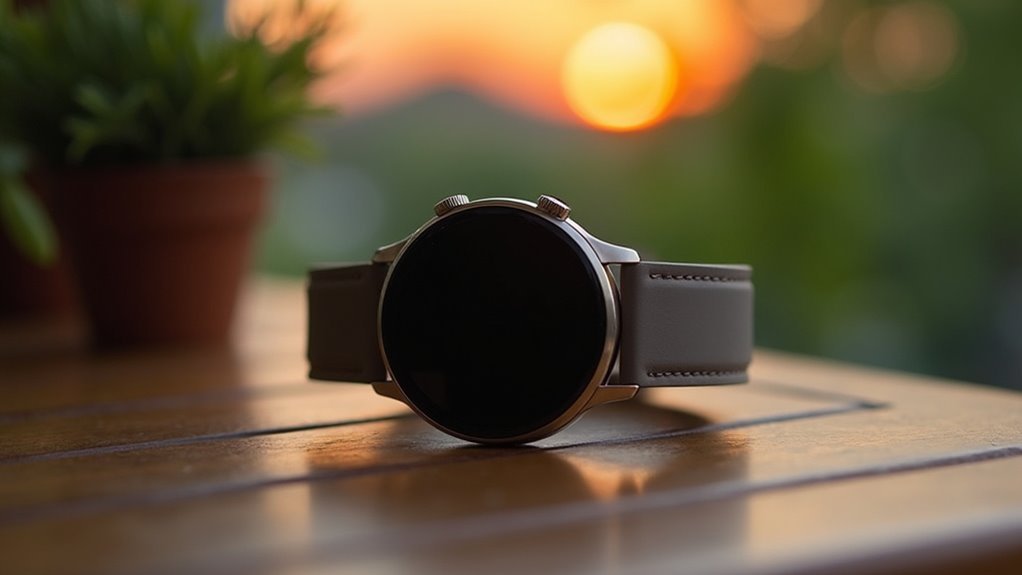
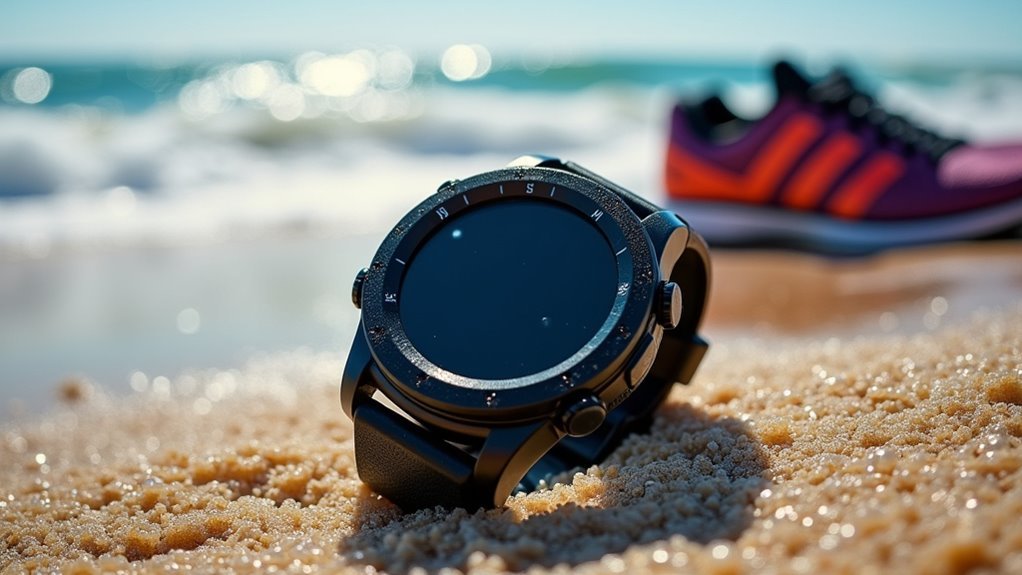
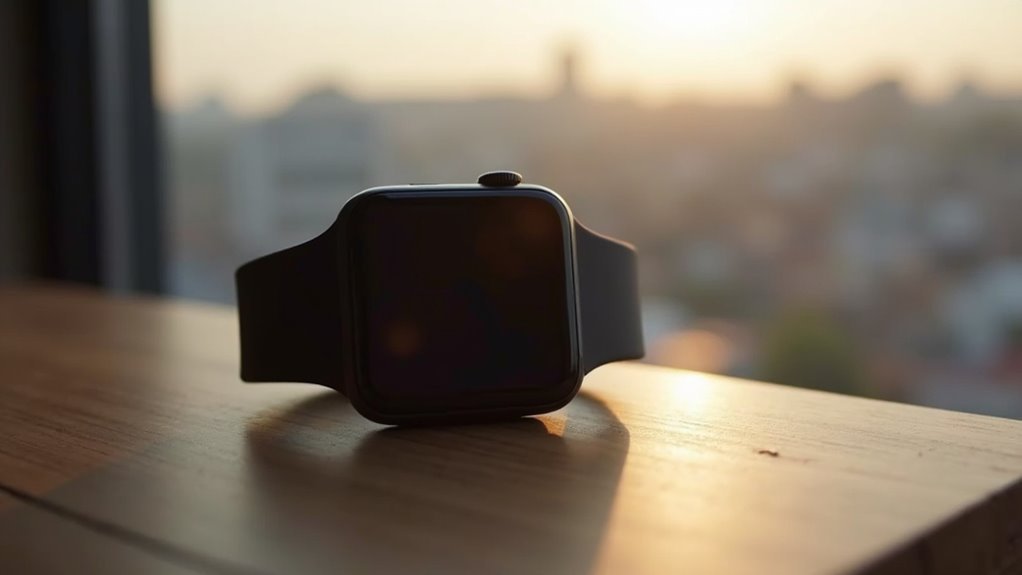
Leave a Reply